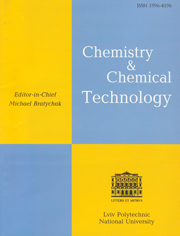Вплив сульфатів калію на процеси тужавіння портландцементного тіста
| Attachment | Size |
|---|---|
| 2.74 MB |
[1] Scrivener, K.L.; John, V.M.; Gartner, E.M. Eco-Efficient Ce-ments: Potential Economically Viable Solutions for a Low-CO2 Cement-Based Materials Industry. Cem. Concr. Res. 2018, 14, 2-26. https://doi.org/10.1016/j.cemconres.2018.03.015
[2] Shi, G.; Bo, Q.; Provis, J. Recent Progress in Low-Carbon
Binders. Cem. Concr. Res. 2019, 122, 227-250. https://doi.org/10.1016/j.cemconres.2019.05.009
[3] Sanytsky, M.; Kropyvnytska, T.; Fischer, H.-B.; Kondratieva, N. Performance of Low Carbon Modified Composite Gypsum Binders with Increased Water Resistance. Chem. Chem. Technol. 2019, 13, 495-502. https://doi.org/10.23939/chcht13.04.495
[4] Sanytsky, M.; Kropyvnytska, T.; Fic, S.; Ivashchyshyn, H. Sustainable Low-Carbon Binders and Concretes. E3S Web
of Conferences 2020, 166, 06007. https://doi.org/10.1051/e3sconf/202016606007
[5] Xu, Q.; Stark, J. Early Hydration of Ordinary Portland Cement with an Alkaline Shotcrete Accelerator. Adv. Cem. Res. 2005, 17, 1-8. https://doi.org/10.1680/adcr.17.1.1.58390
[6] Scrivener, K.L.; Juilland, P.; Monteiro, P.J.M. Advances in Understanding Hydration of Portland Cement. Cem. Concr. Res. 2015, 78, 38-56. https://doi.org/10.1016/j.cemconres.2015.05.025
[7] Ivashchyshyn, H.; Sanytsky, M.; Kropyvnytska, T.; Rusyn, B. Study of Low-Emission Multi-Component Cements with a High Content of Supplementary Cementitious Materials. East.-Eur. J. Enterp. Technol. 2019, 4, 39-47. https://doi.org/10.15587/1729-4061.2019.175472
[8] Liu, B.; Shi, J.; Liang, H.; Jiang, J.; Yang, Y.; He, Z. Synergistic Enhancement of Mechanical Property of the High Replacement Low-Calcium Ultrafine Fly Ash Blended Cement Paste by Multiple Chemical Activators. J. Build. Eng. 2020, 32, 101520. https://doi.org/10.1016/j.jobe.2020.101520
[9] Sanytsky, M.; Usherov-Marshak, A.; Kropyvnytska, T.; Heviuk, I. Performance of Multicomponent Portland Cements Containing Granulated Blast Furnace Slag, Zeolite, and Limestone. Cem. Wapno Beton 2020, 25, 416-427. https://doi.org/10.32047/CWB.2020.25.5.7
[10] Kryvenko, P.; Runova, R.; Rudenko, I.; Skorik, V.; Omelchuk, V. Analysis of Plasticizer Effectiveness During Alkaline Cement Structure Formation. East.-Eur. J. Enterp. Technol. 2017, 4, 35-41. https://doi.org/10.15587/1729-4061.2017.106803
[11] Kovalchuk, O.; Grabovchak, V.; Govdun, Y. Alkali Activated Cements Mix Design for Concretes Application in High Corrosive Conditions. MATEC Web of Conferences 2018, 230, 03007. https://doi.org/10.1051/matecconf/201823003007
[12] Schneider, M. The Cement Industry on the Way to Low-Carbon Future. Cem. Concr. Res. 2019, 124, 105792. https://doi.org/10.1016/j.cemconres.2019.105792
[13] Chatterjee, A.; Sui, T. Alternative Fuels – Effects on Clinker Process and Properties. Cem. Concr. Res. 2019, 123, 105777. https://doi.org/10.1016/j.cemconres.2019.105777
[14] Kryvenko, P.; Sanytsky, M.; Kropyvnytska, T.; Kotiv, R. Deсorative Multi-Component Alkali Activated Cements for Resto-ration and Finishing Works. Adv. Mat. Res. 2014, 897, 45-48. https://doi.org/10.4028/www.scientific.net/AMR.897.45
[15] Sobol, K.; Solodkyy, S.; Petrovska, N.; Belov, S.; Hunyak, O.; Hidei, V. Chemical Composition and Hydraulic Properties
of Incinerated Wastepaper Sludge. Chem. Chem. Technol. 2020, 14, 538-544. https://doi.org/10.23939/chcht14.04.538
[16] Kroviakov, S.; Volchuk, V.; Zavoloka, M.; Krizhanovsky, V. Search for Ranking Approaches of Expanded Clay Concrete Quality Criteria. Materials Science Forum 2019, 968, 20-25. https://doi.org/10.4028/www.scientific.net/MSF.968.20
[17] Sant, G.; Kumar, A.; Patapy, C.; Le Saout, G.; Scrivener, K. The Influence of Sodium and Potassium Hydroxide on Volume Changes in Cementitious Materials. Cem. Concr. Res. 2012, 42, 1447-1455. https://doi.org/10.1016/j.cemconres.2012.08.012
[18] Savchuk, Y.; Plugin, A.; Lyuty, L.; Pluhin, O.; Borziak, O. Study of Influence of the Alkaline Component on the Physico-Mechanical Properties of the Low Clinker and Clinkerless
Waterproof Compositions. MATEC Web of Conferences 2018, 230, 03018. https://doi.org/10.1051/matecconf/201823003018
[19] Li, N.; Shi, C.; Zhang, Z. Understanding the Roles
of Activators Towards Setting and Hardening Control of Alkali-Activated Slag Cement. Compos. B. Eng. 2019, 171, 34-45. https://doi.org/10.1016/j.compositesb.2019.04.024
[20] Kochubei, V.; Yaholnyk, S.; Bets, M.; Malovanyy, M. Use of Activated Clinoptilolite for Direct Dye-Contained Wastewater Treatment. Chem. Chem. Technol. 2020, 14, 386-393. https://doi.org/10.23939/chcht14.03.386
[21] Zajac, M.; Wieczorek, M.; Lothenbach, B.; Bullerjahn, F.; Schmidt, V.M.; Ben Haha, M. Effect of Alkali and Sulfate on Early Hydration of Portland Cements at High Water to Cement Ratio. Constr. Build. Mater. 2022, 345, 128283 https://doi.org/10.1016/j.conbuildmat.2022.128283
[22] Mota, B.; Matschei, T.; Scrivener, K. The Influence of Sodium Salts and Gypsum on Alite Hydration. Cem. Concr. Res. 2015, 75, 53-65. https://doi.org/10.1016/j.cemconres.2015.04.015
[23] Aggoun, S., Cheikh Zouaoui, M.; Chikh, N.; Duval, R. Effect of Some Admixtures on the Setting Time and Strength Evolution of Cement Pastes at Early Ages. Constr. Build. Mater. 2008, 22,
106-110. https://doi.org/10.1016/j.conbuildmat.2006.05.043
[24] Ma, Y.; Qian, J. Influence of Alkali Sulfates in Clinker on the Hydration and Hardening of Portland Cement. Constr. Build. Mater. 2018, 180, 351-363. https://doi.org/10.1016/j.conbuildmat.2018.05.196
[25] Sun, H.; Qian, J.; Xiong, Q.; Yang, S.; Niu, M.; Deng, L.; Huang, Y. Effects of Alkali Sulfates in Clinker on Hydration and Hardening Performance of Portland Cement. Adv. Cem. Res. 2018, 30, 172-184. https://doi.org/10.1680/jadcr.17.00030
[26] Ma, Y.; Qian, J. Effect of Alkali Sulfates in Clinker
on Hydration and Hardening Properties of Cement Incorporating SCMs. Adv. Cem. Res. 2022, Ahead of Print, pp. 1–37. https://doi.org/10.1680/jadcr.21.00110
[27] Smaoui, N.; Bérubé, M.; Fournier, B.; Bissonnette, B.; Durand, B. Effects of Alkali Addition on the Mechanical Properties and Durability of Concrete. Cem. Concr. Res. 2005, 35, 203-212. https://doi.org/10.1016/j.cemconres.2004.05.007










